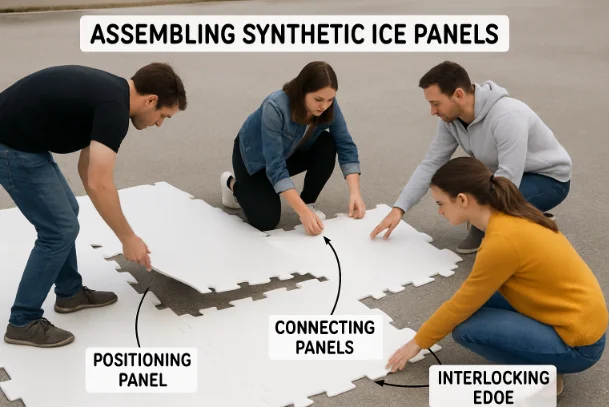Key Takeaways:
- Proper installation and regular maintenance are crucial for optimal performance and longevity of synthetic ice rinks.
- Daily cleaning and periodic inspections help maintain a smooth and safe skating surface.
- Environmental benefits include reduced energy and water usage compared to traditional ice rinks.
Understanding Synthetic Ice Surfaces
Synthetic ice rinks have become an increasingly popular solution for year-round skating, thanks to advanced high-density polyethylene panels that eliminate the need for refrigeration. Facilities seeking to optimize their space, reduce operational costs, and enhance sustainability often opt for synthetic ice for commercial use as an alternative to traditional ice rinks. These synthetic panels can be used indoors or outdoors, making them versatile for a wide range of applications.
Choosing the right synthetic ice product is crucial for performance, longevity, and user satisfaction. Commercial-grade panels not only provide a glide similar to real ice but also require much less energy and ongoing resource investment. As a result, rink owners can focus on providing a seamless skating experience while supporting eco-friendly initiatives.
Pre-Installation Considerations
A successful installation begins with careful planning and site evaluation. Ensuring the surface is level and stable is essential to prevent uneven seams, tripping hazards, and premature wear. Whether installed indoors or exposed to the elements outdoors, understanding the environmental factors—such as sun exposure, temperature fluctuations, and shelter—can help maximize the rink’s life and performance.
It’s important to think through location and usage goals. For instance, outdoor installations in sunny regions may require UV-resistant panels, while high-traffic commercial spaces demand extra durability and safety features. Consulting with experts can further streamline the process and prevent common pitfalls. For additional guidance, large publications like Popular Mechanics offer resources about prepping spaces for synthetic surfaces.
Step-by-Step Installation Guide
- Panel Layout: Begin by arranging the interlocking panels as specified by the manufacturer. Start from one corner and systematically work outwards for a seamless connection.
- Interlocking Panels: Use the integrated interlocks or cam locks provided to securely fasten panels, ensuring that every seam is flush and tight to minimize friction and provide a smooth skating surface.
- Quality Check: After the panels are laid and locked, inspect for gaps, irregularities, or misalignments. Make necessary adjustments immediately to ensure optimal safety and performance.
Daily Maintenance Practices
Routine maintenance keeps the skating surface safe, attractive, and high-performing. Dust, dirt, and debris should be removed daily using a soft-bristle broom, mop, or a vacuum designed for hard floors. For more stubborn marks or scuffs, apply a mild cleaning solution designed for synthetic surfaces and avoid any harsh chemicals that could impair glide or degrade the panels.
- Cleaning: Consistent cleaning is key. Schedule regular wipe-downs and remove contaminants that could scratch the panels or hinder skating performance.
- Inspection: Examine the rink regularly for signs of wear, such as deep scratches, worn edges, or shifting panels. Address problems promptly to extend the lifespan of the rink and ensure user safety.
Enhancing Skating Performance
The quality of the skating experience on synthetic ice can be further improved with a few best practices. Always ensure skates are kept sharp for enhanced grip and control, as dull blades can make skating more difficult and impact the surface over time. Many rink owners apply commercially available glide enhancers for a slicker surface that better mimics real ice, especially in high-traffic or professional settings.
- Skate Maintenance: Make regular skate sharpening part of rink maintenance policies for both customer and rental skates.
- Glide Enhancers: Apply as recommended by the panel manufacturer to reduce friction and optimize glide, but avoid overuse, which can create build-up.
Environmental and Cost Benefits
Synthetic ice rinks are revolutionizing the skating industry with environmental and economic advantages. Unlike traditional ice, synthetic surfaces require no refrigeration, freezing, or water for resurfacing. This reduction in energy and water use translates to significantly smaller operational footprints and running costs. Facility managers achieve greater flexibility in usage and scheduling, without seasonal constraints or heavy utility bills. According to The New York Times, synthetic alternatives are increasingly favored as communities pursue more climate-conscious recreational options.
- Energy Efficiency: Permanent cost reductions due to the lack of refrigeration and reduced need for complex infrastructure.
- Water Conservation: No water required for ice creation or resurfacing—supporting sustainability goals for schools, parks, and private venues.
- Cost Savings: Slashed ongoing expenses through fewer repairs, lower energy bills, and minimal staffing requirements.
Safety Measures and Best Practices
Safety remains a priority in any skating environment. Encourage all participants to wear helmets, knee pads, and elbow pads to reduce the risk of injury. Post clear signage outlining rink rules and safe skating etiquette, such as speed limits or directional flow. Employ trained staff to supervise busy sessions, provide assistance, and enforce safety policies consistently throughout operational hours.
- Protective Gear: Helmets and pads are vital, especially for children and new skaters.
- Clear Signage: Prominently display safety protocols and rink usage rules.
- Supervision: Maintain an active presence of trained personnel for both crowd control and emergency response.
Conclusion
Adhering to best practices for installing and maintaining synthetic ice rinks ensures the delivery of a safe, enjoyable, and sustainable skating experience. With regular cleaning, prompt maintenance, and preventative safety measures, facilities will not only lower their operational costs but also provide an inviting environment for skaters year-round. As technology continues to advance, synthetic ice solutions promise even greater performance and efficiency for both community and commercial rinks alike.

